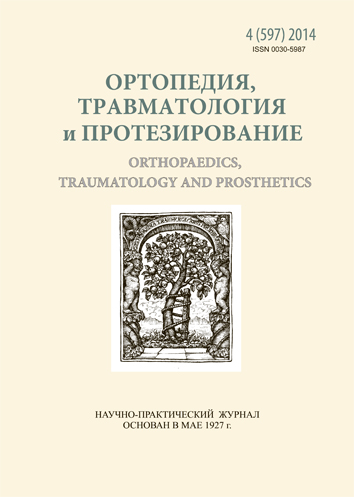Assessment of strain and deformation of the «bone – fixateur» system in osteosynthesis of the lateral malleolar fractures
DOI:
https://doi.org/10.15674/0030-59872014414-19Keywords:
ankle joint, biomechanics, unstable fracture-dislocationsAbstract
Injuries of the ankle joint is one of the main causes of disability and poor outcomes which are caused by inadequate reposition, imperfect osteosynthesis and secondary displacement of fragments. Qualitative and reliable stabilization of the lateral malleolar bone fragments essentially depends on the design of the fixateur. Objective: based on the analysis of the stress-strain state of the system «bone – fixateur» to evaluate the effectiveness of the proposed fixateur for osteosynthesis of infrasyndesmotic lateral malleolar fractures. Methods: The finite element analysis with ANSYS software complex and model of the system «bone – fixateur» that limited by the fibula the shape of which was simplified for the construction being symmetric in the frontal plane. Models were built in the program AUTOCAD. Geometry of sections of bone meets the real size of the adult. The criterion for evaluation of the efficiency of plate-fixateur selected values of stresses in bone tissue and movement of the fragment points — opening of the fracture. An additional criterion was the value of stresses in the plate. Results revealed that the greatest amounts in bone tissue are normal stresses σ acting in the direction of the fibular axis. They occur in cortical bone at the edges of the holes for the screws. Stressed state of bone turned significantly heterogeneous. For heavy loads (half from critical for syndesmotic ligaments breakage) stresses in the plate are dangerous. However, they occur in the areas of concentration but the actual loads will be lower. The most significant deviations of the stress state of the bone occur at the edges of the holes for the screws, in the joints cortical and spongiosal bone tissue and in the areas of the load application. The largest loads were normal tension and compressive stresses in the plate due to its curve with maximum performance at the edge the hole for the third top screw from the internal part of the plate. The value of expansion of the fracture was not significant. Conclusions: The proposed fixateur has shown its high efficiency. It is important to consider the characteristics associated with the nature of the maximum stresses arising in areas of concentration, and not to produce constructs for osteosynthesis of brittle materials.
References
- Epidemiology of ankle fractures. A prospective population-based study of 212 cases in Aalborg, Denmark / S. L. Jensen, B. K. Andresen, S. Mencke [et al.] // A. Orthop. Scand. — 1998. — Vol. 69. — P. 48–50.
- The epidemic of ankle fractures in the elderly — is surgical treatment warranted? / M. Salai, I. Dudkiewicz, I. Novikov [et al.] // A. Orthop. Trauma. Surg. — 2000. — Vol. 120. — Р. 511–513.
Downloads
How to Cite
Issue
Section
License
Copyright (c) 2014 Maksim Golovakha, Maksym Kozhemyaka, Sergei Panchenko, Vasil Krasovskiy

This work is licensed under a Creative Commons Attribution 4.0 International License.
The authors retain the right of authorship of their manuscript and pass the journal the right of the first publication of this article, which automatically become available from the date of publication under the terms of Creative Commons Attribution License, which allows others to freely distribute the published manuscript with mandatory linking to authors of the original research and the first publication of this one in this journal.
Authors have the right to enter into a separate supplemental agreement on the additional non-exclusive distribution of manuscript in the form in which it was published by the journal (i.e. to put work in electronic storage of an institution or publish as a part of the book) while maintaining the reference to the first publication of the manuscript in this journal.
The editorial policy of the journal allows authors and encourages manuscript accommodation online (i.e. in storage of an institution or on the personal websites) as before submission of the manuscript to the editorial office, and during its editorial processing because it contributes to productive scientific discussion and positively affects the efficiency and dynamics of the published manuscript citation (see The Effect of Open Access).














